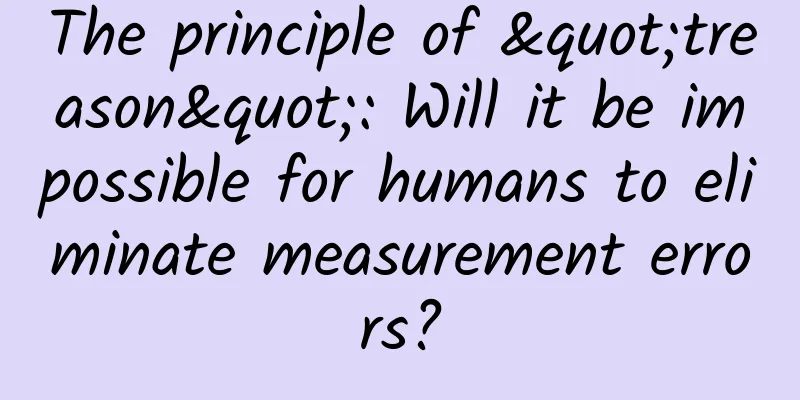The principle of "treason": Will it be impossible for humans to eliminate measurement errors?

|
In 1924, Bohr welcomed a 23-year-old young man to his institute in Denmark. Over the three years, Bohr developed a deep friendship with him. After returning to Germany, the young man made a profound insight: no matter what method humans use, it will never be possible to eliminate measurement errors. This young man was Heisenberg. Scientists in the past always believed that as long as our measuring tools were good enough, we could measure the target object as accurately as possible. But Heisenberg said: I'm sorry, we will never be able to measure the speed and exact position of an electron at the same time. Why? Because our measurement behavior itself will definitely interfere with the movement of electrons. Any measurement behavior, in essence, is to observe the light reflected from the object. For example, when we look at any object with our eyes, what we really see is actually the light reflected from the object. All objects to be measured must be illuminated by light. Since light is composed of photons, these photons are like bullets. Using them to illuminate electrons is like using a bullet to hit another bullet. At the moment of being hit by a photon, the electron's state of motion will inevitably change. If we want to measure the speed of an electron, we must measure the positions of two points on the electron's motion path. Now, as long as you measure the position of any point, the electron's motion state is destroyed, and the time it takes for the electron to reach another point is different from the original time. Therefore, it is theoretically impossible to measure both the position and the speed at the same time. Heisenberg called his insight the "uncertainty principle", and as soon as the paper was published, it caused a great response in the academic community. Bohr, who was far away in Denmark, also saw Heisenberg's paper. He pondered it carefully and was surprised! A problem that had troubled him for many years was suddenly solved, and he also came up with an idea that was ten times bolder. Bohr believed that it was not wrong to measure the speed and position of electrons at the same time, but the reason was not because the measurement behavior interfered with the movement of electrons, but because there was no concept of accurate speed and position for electrons! Schrödinger was right, but only half right. Electrons, like photons, are both particles and waves. When you measure an electron, it behaves as a particle, and when you don't measure it, it is a wave. Bohr finally figured out why electrons orbit around the nucleus but do not emit electromagnetic waves. The reason is simple: electrons do not orbit around the nucleus at all, but spread throughout the orbit in the form of waves. Bohr believed that, in fact, when we do not measure electrons, electrons have no physical shape, they are a kind of wave, just like butter spread on bread, it spreads all over the road, thicker in some places, thinner in others; thicker places indicate a greater probability of being measured, thinner places indicate a smaller probability of being measured. However, the thickness and thinness of butter are not fixed, but show periodic changes with the evolution of time. Isn't the essence of waves a periodic change? If we use the game of whack-a-mole as an analogy, our measurement behavior is like hitting something with a hammer. Sometimes it hits nothing, and sometimes it instantly shrinks the electron wave that permeates the entire road into a point, making it look like it hits a mole. In fact, the mole itself is formed by the hammer. What determines whether the hammer can hit the mole is the probability of hitting it. Even God cannot guarantee that a hammer will hit a mole. In short, the core idea is that as long as we don't measure the electron, its state will always be uncertain, with no definite position or speed. Any measurement behavior can only let us know one of them, not both. This is the first principle of quantum mechanics: the uncertainty principle . As soon as the uncertainty principle was proposed, it was immediately questioned by many people. For most physicists at the time, this was simply outrageous. However, it was this "outrageous" theory that gradually gained empirical support and became one of the important cornerstones of quantum mechanics. This article is a work supported by the Science Popularization China Creation Cultivation Program Author: Science Voice Reviewer: Zhou Xiaoliang, Senior Engineer of Beijing Jiaotong University Physics Laboratory Produced by: China Association for Science and Technology Department of Science Popularization Producer: China Science and Technology Press Co., Ltd., Beijing Zhongke Xinghe Culture Media Co., Ltd. |
>>: Illustrated Science | Why are there no green mammals?
Recommend
How effective is information flow advertising? What are the advantages of information flow advertising?
What is information flow advertising ? "Feed...
Nezha used lotus root powder to rebuild his body! So what is the nutritional code of lotus root powder?
Image from: People's Daily Just now, "Ne...
What did you eat for lunch the day before yesterday? Maybe it’s a good thing that you forgot…
Now! Right now! Think back to what you had for lu...
I'm not hungry but I still want to eat. Am I gluttonous?
There are many such scenes in life: it is time to...
Holiday brand marketing promotion skills and strategies!
Just as everyone has a difference between their t...
Tips for promoting your notes on Xiaohongshu!
In the era of social e-commerce and content e-com...
How to refine bidding promotion accounts and improve promotion effects!
When we do promotion, the proportion of bidding p...
Short video promotion skills in the home improvement industry, with successful cases!
Advertising is the first impression that consumer...
How to buy special government bonds during the epidemic? What are the ways to purchase the 2020 special anti-epidemic government bonds?
On June 15, the Ministry of Finance issued an ann...
Gartner: Survey shows that only 29% of respondents are currently using the Internet of Things
Gartner's latest research found that differen...
Why do you get angry when you're hungry? You may have "hunger rage"!
When you're hungry, do you feel irritable and...
Snack industry Douyin self-broadcast promotion strategy
During this year’s Double 11, many leading snack ...
WeChat Mini Program has been taken offline due to violations of regulations. What should we do if the Mini Program has been taken offline due to violations of regulations?
Before we knew it, WeChat Mini Programs have been ...
Stop thawing the meat in water, this practice is really not advisable!
Do you have a lot of frozen meat in your refriger...
Four national departments jointly issued a document, stating that these examinations in hospitals will no longer need to be repeated!
Four national departments jointly issued a docume...









